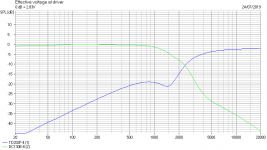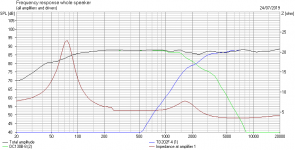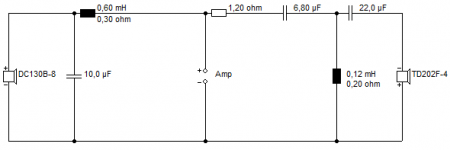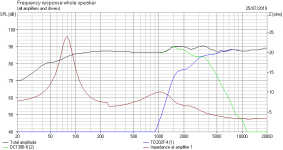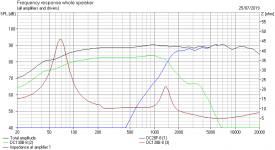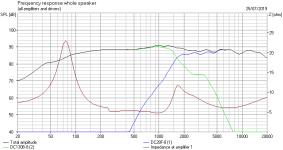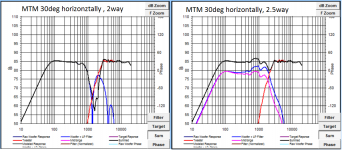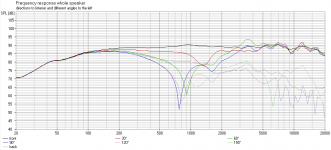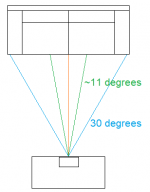I'm going to build a small sound room soon, and when that happens, my main system (which is a big stereo system) will move to the sound room, where I will listen to most of my music. When that happens, I want to set up a new system, but I want it 5.1 capable for movies because I've got a nice projector setup. The room is about 7.5 x 4 meters.
I initially wanted to use Visaton W130S because I've always liked the idea of a 5" bookshelf based on these, but I had to pull too many tricks in the crossover to get them to behave. I thought I'll try a Dayton Audio DC130B-8 speaker, and it looks a lot better.
I thought I'll go with a Dayton Audio TD20F-4 tweeter - it looks perfect for my purpose. I don't want to spend too much, but I want to maximize quality for the price.
I've got a nice 8" woofer to fill the bass.
The DC130B-8 has a peak at about 4k Hz, and the TD20F-4 has a bump at about 1.6k Hz. These peaks I sorted with notches integrated into the crossover.
1. Are these Dayton Audio drivers as good as they look?
2. Am I being silly with my crossover design?
Dayton Audio is telling me I'll get 88 dB for 2.83 V. Can this be trusted of this small driver?
Phase response looks ok, and I can play around with driver positioning (forward and backward) if need be.
I initially wanted to use Visaton W130S because I've always liked the idea of a 5" bookshelf based on these, but I had to pull too many tricks in the crossover to get them to behave. I thought I'll try a Dayton Audio DC130B-8 speaker, and it looks a lot better.
I thought I'll go with a Dayton Audio TD20F-4 tweeter - it looks perfect for my purpose. I don't want to spend too much, but I want to maximize quality for the price.
I've got a nice 8" woofer to fill the bass.
The DC130B-8 has a peak at about 4k Hz, and the TD20F-4 has a bump at about 1.6k Hz. These peaks I sorted with notches integrated into the crossover.
1. Are these Dayton Audio drivers as good as they look?
2. Am I being silly with my crossover design?
Dayton Audio is telling me I'll get 88 dB for 2.83 V. Can this be trusted of this small driver?
Phase response looks ok, and I can play around with driver positioning (forward and backward) if need be.
Attachments
Did you model the baffle step?
Wolf
More or less. There wasn't much to do in that regard with the DC130B-8. The 10 ohm and 22 uF did a good job there.
Perhaps I can explain the crossover a bit.
I started by sorting out the impedance of the midbass with the 8.2 ohm and 10 uF because its impedance increased a lot, and enough near the crossover that I wanted to flatten it.
I then used the first 0.5 mH as a first order, calculated on the 6 ohms of the midbass.
Then I added the baffle step - it's only about 1 dB.
I added the notch to get rid of the 3 - 4 kHz peak to prevent break up.
The second 0.5 mH is for the baffle step, to continue the filter, and the 15 uF increases the order of the filter.
For the tweeter, I started with a first-order with the 10 uF, and then I added the notch to pull down the 1.3 - 2 kHz peak, also in an attempt to prevent too much power near resonance (~1670 Hz). The 1.5 ohm seems to bring the tweeter level on par with the midbass.
My concern with the tweeter notch is that it's fairly close to the crossover frequency, and I'm not sure if this will negatively impact the phase between the midbass and tweeter.
I started by sorting out the impedance of the midbass with the 8.2 ohm and 10 uF because its impedance increased a lot, and enough near the crossover that I wanted to flatten it.
I then used the first 0.5 mH as a first order, calculated on the 6 ohms of the midbass.
Then I added the baffle step - it's only about 1 dB.
I added the notch to get rid of the 3 - 4 kHz peak to prevent break up.
The second 0.5 mH is for the baffle step, to continue the filter, and the 15 uF increases the order of the filter.
For the tweeter, I started with a first-order with the 10 uF, and then I added the notch to pull down the 1.3 - 2 kHz peak, also in an attempt to prevent too much power near resonance (~1670 Hz). The 1.5 ohm seems to bring the tweeter level on par with the midbass.
My concern with the tweeter notch is that it's fairly close to the crossover frequency, and I'm not sure if this will negatively impact the phase between the midbass and tweeter.
It looks as if you misunderstood the question. A project file attached is all that is needed to clarify. I have built a long time ago a 2 way of w130s-8 and g20. For the midwoofer filter, it sufficed a 2nd order electrical. Boxsim has the tendency to raise suspicion and paranoia when one tries to modell a solution, hence these kind of circuits are the result of it. I believe that people are too focused on graphical appearances, instead on what it will sound like. Anyway, your speakers, your money.
It looks as if you misunderstood the question. A project file attached is all that is needed to clarify. I have built a long time ago a 2 way of w130s-8 and g20. For the midwoofer filter, it sufficed a 2nd order electrical. Boxsim has the tendency to raise suspicion and paranoia when one tries to modell a solution, hence these kind of circuits are the result of it. I believe that people are too focused on graphical appearances, instead on what it will sound like. Anyway, your speakers, your money.
This is why I ask the question (thank you!). I see the peaks of the midbass and tweeter in the specs, and I already designed the notches before plugging into Boxsim. I mean, I did one or two small tweaks once there, but I had the designs calculated first.
So what's the solution according to your wisdom? A 2nd order filter on woofer and tweeter, and that's it? Maybe the baffle-step too? That would certainly suit me better.
If you remember my big 2-way build, I ended up actually keeping a 4 dB peak in the 1 - 2 kHz region because it's what I ended up liking the most when listening. If I can simplify the crossover more, I would prefer that as a starting point.
If I can, I'd like to stick with the TD20F, unless someone can really advise against it.
So what's the solution according to your wisdom? A 2nd order filter on woofer and tweeter, and that's it? Maybe the baffle-step too? That would certainly suit me better.
The solution includes measuring for myself and applying as simple filters as possible, a minimum of 2nd order electrical on midwoofer, and 3rd order electrical on tweeter if the drivers were on a flat baffle, without slanting. The asymetrical filter is for phase correction and then there is only the question of padding hf down and if the baffle step is to be factored in or not and if, how much then. Speakers positioned against the wall and in corners sound better without bsc, depending on one's own taste. Increased filter complexity can occasionally be justified.
edit: bsc is best manipulated by the value of the low pass inductor of the midwoofer if it works, otherwise an extra filter is to be thrown in.
Last edited:
The solution includes measuring for myself and applying as simple filters as possible, a minimum of 2nd order electrical on midwoofer, and 3rd order electrical on tweeter if the drivers were on a flat baffle, without slanting. The asymetrical filter is for phase correction and then there is only the question of padding hf down and if the baffle step is to be factored in or not and if, how much then. Speakers positioned against the wall and in corners sound better without bsc, depending on one's own taste. Increased filter complexity can occasionally be justified.
edit: bsc is best manipulated by the value of the low pass inductor of the midwoofer if it works, otherwise an extra filter is to be thrown in.
I like the way you think. This is good, realistic advice.
The bump at 1.6KHz is due to the resonance, I'm pretty confident you can get it flattened if you move away the crossover point from it. Frankly I wouldn't choose a near 2KHz crossover point for this tweeter. If you want to retain the 2KHz crossover point choose another tweeter IMHO.I thought I'll go with a Dayton Audio TD20F-4 tweeter - it looks perfect for my purpose.
As for the midwoofer, the breakup region seems smooth enough not to worry about.
Before choosing another tweeter, try to simulate a LR4 crossover at around 3.5KHz, with a 2nd order electrical on the woofer and a 3rd one on the tweeter, with the right choice of components, you can get away from notches, zobel and dedicated bsc components.
Ralf
Edit: I see that Lojzek in the meantime recommended the same, count it double
Last edited:
I thought about things a little more based on the generous advice. I put in a DC28-F tweeter rather, and I set the crossover lower. I came to the conclusion that the TD20F wouldn't keep up in the center channel.
Things were a little easier to design at the lower crossover point.
First two images are for the speaker (front and rear channels), second two are for the center channel.
I think this is a bit neater?
Things were a little easier to design at the lower crossover point.
First two images are for the speaker (front and rear channels), second two are for the center channel.
I think this is a bit neater?
Attachments
Thanks. The centre you propose sounds like a great idea, but it won't fit. The MTM style will give good response above and below, and the space I have for it is near the bottom of the projected picture, also below the TV. The design will fit nicely into the spot designated for it.
One final thought on centre channel speaker
To get the horizontally emitted sound as coherent as possible with an mtm, you will reduce the bad lobing if you design a 2.5 way crossover filter. Ctc distance between tw and midwoofer (5.25" class) is 12.5 cm, the listening distance 2m, so was the data simulated upon. Midwoofers were in parallel. One had a 2nd order electrical, the other 1st order.
To get the horizontally emitted sound as coherent as possible with an mtm, you will reduce the bad lobing if you design a 2.5 way crossover filter. Ctc distance between tw and midwoofer (5.25" class) is 12.5 cm, the listening distance 2m, so was the data simulated upon. Midwoofers were in parallel. One had a 2nd order electrical, the other 1st order.
Attachments
Last edited:
Yes, I'm not too sure of the MTM for left and right off-axis, especially since a center speaker is meant for voice, and my crossover is right there in the voice.
I'm not 100% sure what you mean by a 2.5 way crossover - my guess is that I will cross the tweeter a bit lower and the woofer a bit higher, but that would give a big increase on-axis.
I did think about this, and my listening position is about from -12 degrees to 12 degrees, so I thought it should be ok. I also went with the DC28FT, so it's 8.5 cm wide, spacing the mid and tweeter at a tiny bit over 11.5 cm.
Maybe if I did 2 2-way's in series/parallel on their side, bottom-to-bottom, and then I can tilt it up a bit. I'll investigate that later, and power a possibility.
See my attachments for the off-axis to the left/right, and my listening area.
I'm not 100% sure what you mean by a 2.5 way crossover - my guess is that I will cross the tweeter a bit lower and the woofer a bit higher, but that would give a big increase on-axis.
I did think about this, and my listening position is about from -12 degrees to 12 degrees, so I thought it should be ok. I also went with the DC28FT, so it's 8.5 cm wide, spacing the mid and tweeter at a tiny bit over 11.5 cm.
Maybe if I did 2 2-way's in series/parallel on their side, bottom-to-bottom, and then I can tilt it up a bit. I'll investigate that later, and power a possibility.
See my attachments for the off-axis to the left/right, and my listening area.
Attachments
This is a judgement on the frequency response.I actually like what adding a little BSC does to the phase response.
Also, this frequency response is a limited view, which has potential to change once you put this system into a room.
- Status
- This old topic is closed. If you want to reopen this topic, contact a moderator using the "Report Post" button.
- Home
- Loudspeakers
- Multi-Way
- Small bookshelf based 5.1 system - crossover notches

